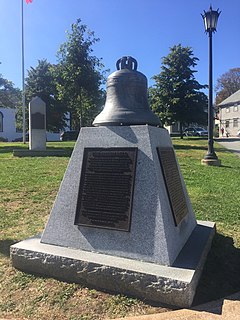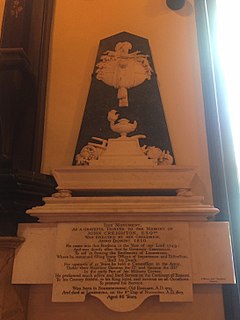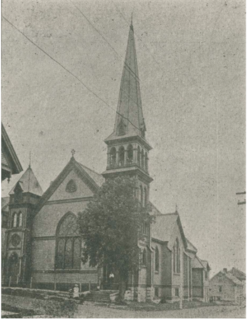
Lunenburg is a port town on the South Shore of Nova Scotia, Canada. Founded in 1753, the town was one of the first British attempts to settle Protestants in Nova Scotia.

St. Paul's Church is an evangelical Anglican church in downtown Halifax, Nova Scotia, within the Diocese of Nova Scotia and Prince Edward Island of the Anglican Church of Canada. It is located at the south end of the Grand Parade, an open square in downtown Halifax with Halifax City Hall at the northern end.

The Old Burying Ground is a historic cemetery in Halifax, Nova Scotia, Canada. It is located at the intersection of Barrington Street and Spring Garden Road in Downtown Halifax.

Guysborough is an unincorporated Canadian community in Guysborough County, Nova Scotia.

Dettlieb Christopher Jessen was one of the founding fathers of Lunenburg, Nova Scotia, and helped the village through Father Le Loutre's War, the French and Indian War and the American Revolution. He was German born. After his emigration to Canada, he became a militia leader, judge, and politician in Nova Scotia. His first name also appears as "Detleff". He represented Lunenburg County in the Nova Scotia House of Assembly from 1785 to 1793.
Sebastian Zouberbuhler was one of the founding fathers of Lunenburg, Nova Scotia.

John Creighton was one of the founding fathers of Lunenburg, Nova Scotia. He led the settlement through the turbulent times of Father Le Loutre's War, the French and Indian War and the American Revolution. He represented Lunenburg County in the Nova Scotia House of Assembly from 1770 to 1775. After establishing the town, he lived the rest of his life in the village until he died fifty-four years later.

St. George's Anglican Church is an historic Carpenter Gothic style Anglican church building located at 216 Main Street in Parrsboro, Nova Scotia, Canada.

The Raid on Lunenburg occurred during the American Revolution when the US privateer, Captain Noah Stoddard of Fairhaven, Massachusetts, and four other privateer vessels attacked the British settlement at Lunenburg, Nova Scotia on July 1, 1782. The raid was the last major privateer attack on a Nova Scotia community during the war.

The Foreign Protestants were a group of French Lutheran and German Protestant immigrants to Nova Scotia. They largely settled in Halifax at Gottingen Street and Dutch Village Road as well as Lunenburg.

The Lunenburg campaign was executed by the Mi'kmaq militia and Acadian militia against the Foreign Protestants who the British had settled on the Lunenburg Peninsula during the French and Indian War. The British deployed Joseph Gorham and his Rangers along with Captain Rudolf Faesch and regular troops of the 60th Regiment of Foot to defend Lunenburg. The campaign was so successful, by November 1758, the members of the House of Assembly for Lunenburg stated "they received no benefit from His Majesty's Troops or Rangers" and required more protection.

Major Patrick Sutherland served as commander at Fort Edward and then became one of the founding fathers of Lunenburg, Nova Scotia. He remained in command at Lunenburg until his death 15 years after establishing the town. He helped the village survive Father Le Loutre's War and the French and Indian War. During this time he quelled the Lunenburg Rebellion and built blockhouses to protect the village after the Raid on Lunenburg (1756). He participated in the Siege of Louisbourg (1758) and in protecting the village Lunenburg from the subsequent Lunenburg Campaign (1758). Sutherland became a justice of the peace (1759), custos rotulorum (1760) and a justice of the Inferior Court of Common Pleas for Lunenburg County (1760).

The Zion Evangelical Lutheran Church is a church in Lunenburg, Nova Scotia. The church is the home of the oldest active Lutheran congregation in Canada. German Lutheran settlers arrived in 1753 and held services in the open air and later at St. John's Anglican Church (Lunenburg). The first church on this site was built in 1772 in preparation for the arrival of its first pastor, the Rev. Mr. Friederich Schultz at Lunenburg. He stayed for 8 years.
James Cuppaidge Cochran (1798–1880) was an Anglican priest and editor in Lunenburg and Halifax, Nova Scotia. He was a minister at St. John's Anglican Church (Lunenburg) (1825-1852). He also published both the Colonial Churchman (1835-1840) in Lunenburg and later the Church Times in Halifax. While in Halifax, he supported the establishment of the Halifax School for the Deaf. He is the son of Rev. William Cochran (clergyman), the founder of King's College, Nova Scotia.

Jean-Baptiste Moreau was first minister at St. John's Anglican Church (Lunenburg) (1753-1770) and one of the founding fathers of the community. He was one of two missionaries who first arrived in Halifax with Edward Cornwallis (1749) and served at St. Paul's Church (Halifax). His wife had the first child born in Halifax and was named Cornwallis after the Governor. Then in 1753 he was sent to help establish Lunenburg, Nova Scotia. Rev Moreau served the community throughout the French and Indian War. He reported to Society for Propagation of the Gospel (SPG) in London, "…the number massacred by Indians in Lunenburg District during the War was 32." He learned the Mi'kmaw language and is reported to have baptised a number of Mi'kmaq children. He is buried in the crypt of St. John's Anglican Church

St. Andrew's Presbyterian Church is a church in Lunenburg, Nova Scotia. The congregation is the longest history of any Presbyterian congregation in Canada. After meeting at a private house, the congregation worshipped in St. John's Anglican Church (Lunenburg) (1759-1770). The first church was built in 1770 and the first minister was Reverend Bruin Romkes Comingo, who served the community for 50 years until he died at age 95 (1820). The current church was built in the neo-gothic style and dates from 1828.
The Hillcrest Cemetery is the oldest protestant cemetery in Lunenburg, Nova Scotia and one of the oldest in Canada. The cemetery is adjacent to the Lunenburg Academy. The oldest marker is dated 1761, eight years after Lunenburg was established. Hillcrest Cemetery contains 5 Commonwealth war graves from World War I and one from World War II.

Roger Aitken was a Scottish Anglican priest known for his service as a missionary at Lunenburg, Nova Scotia (1817-1825) for the Society for the Propagation of the Gospel in Foreign Parts. He was the rector at St. John's Anglican Church and was instrumental in gaining construction of the Rectory and in founding St. Peter's Anglican Church, New Dublin.

St. Peter's Anglican Church is a church in West LaHave, Nova Scotia that was established in 1818 by Roger Aitken, the missionary at Lunenburg for Society for the Propagation of the Gospel in Foreign Parts (1817-1825). The first church was built in 1829 and consecrated in 1834. The church remains active. Aitken gave to the church the oldest known Anglican Chalice and Paten in Canada.

Thomas Shreve was a Loyalist during the American Revolution and later served as the first rector of St. George's Anglican Church (1787) and then became a prominent minister of St. John's Anglican Church (Lunenburg), Nova Scotia.




























